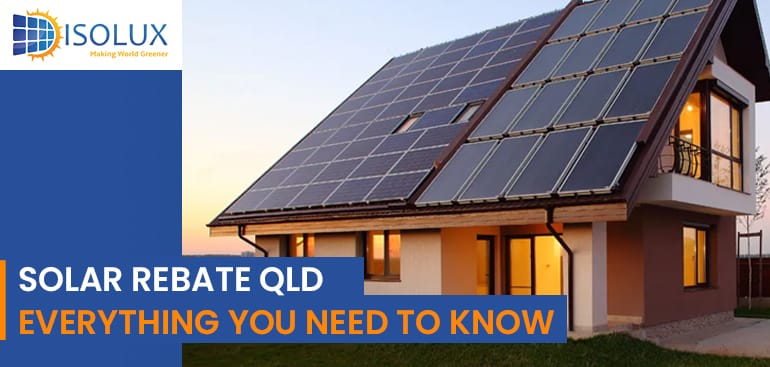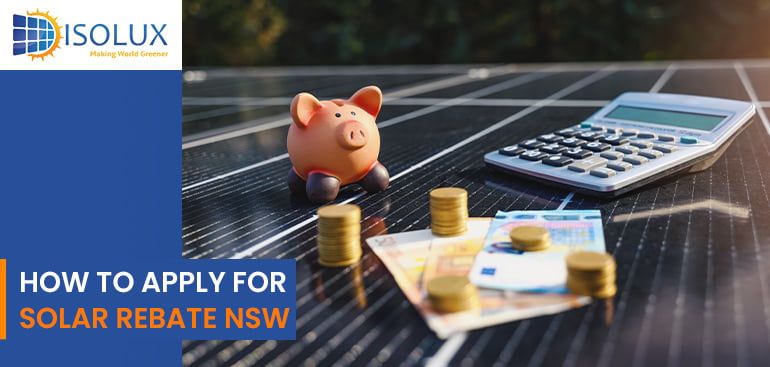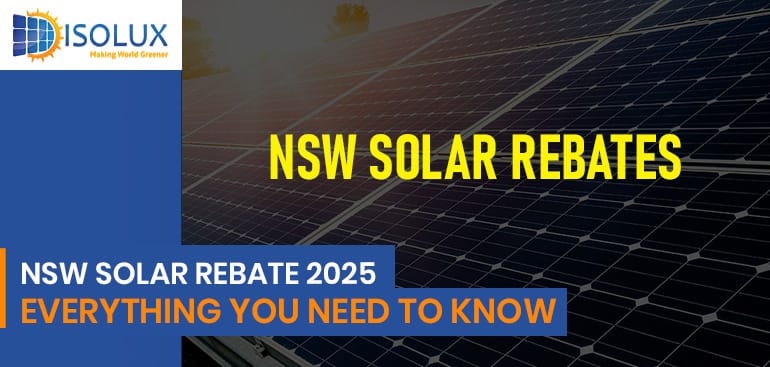To guide Queensland residents on going solar, here’s an in-depth overview of the solar rebates and incentives available in Queensland (QLD), especially for those in Brisbane. With Isolux Solar now operating in Queensland, homeowners have more options for installing high-quality solar systems to leverage the state’s rebates and incentives effectively. Let’s understand Solar Rebate QLD and how to claim it.
Queensland Solar Panel Rebate
The federal Small-scale Renewable Energy Scheme (SRES), commonly known as the STC rebate, is available to homeowners and businesses in Queensland. This rebate is calculated based on the amount of sunlight an area receives, meaning Queenslanders—especially those in high-sunshine regions—can maximize their benefits.
For instance, a solar system installed in Brisbane will generate a specific number of Small-scale Technology Certificates (STCs). The number of STCs issued depends on the system’s expected energy production through to 2030. The larger the solar system, the greater the number of STCs you receive.
When you install a solar system, your solar provider typically handles the rebate process on your behalf. The rebate is applied upfront, so you only need to pay the net cost of the system.
When Does the Solar Rebate End in Queensland?
The solar rebate in Queensland ends on December 31, 2030. The current STC rebate for Queensland residents decreases annually and will phase out entirely by the end of 2030.
For Queensland homeowners, this means the earlier you install solar, the more value you can secure from the rebate. This is crucial for those looking to maximize financial returns on their solar investments while the incentive is still in effect.
How to Claim Solar Rebate Queensland
To claim solar rebates in Queensland, follow these steps:
1. Choose an accredited installer: Work with a Clean Energy Council (CEC)-approved installer to ensure eligibility.
2. Complete STC paperwork: Your installer will typically manage the STC registration process, applying the rebate as a direct discount on your purchase price.
3. Claim additional rebates: For battery storage, check eligibility through Queensland’s programs, especially if you meet income-based requirements. These rebates are usually applied directly at the time of purchase, meaning you don’t have to go through a separate claims process.
Who Can Claim the Rebate?
If you’re installing new solar panels, you’re eligible for the rebate. It also applies to system upgrades, panel replacements, and even solar hot water pumps. In 2022 alone, 76,656 Queensland homes and small businesses took advantage of this scheme, bringing the total number of solar-powered homes in the state to 1,079,102, according to the Clean Energy Regulator.
How Do I Know if I’m Eligible?
To claim the rebate, make sure you:
- Use Clean Energy Council (CEC) approved solar panels and components.
- Hire an SAA-accredited installer to carry out the installation.
- Install your system within 12 months of creating the Small-scale Technology Certificates (STCs).
- Keep your system size under 100kW, with a maximum annual production of 250MWh.
Installing solar sooner means greater savings, so if you’re considering making the switch, now is the best time!
Solar Rebates are Available in QLD?
Currently, three solar incentives are available in Queensland:
1. The Small-Scale Renewable Energy Scheme
2. Queensland Battery Booster program
3. Solar feed-in tariffs
1. Small-scale Renewable Energy Scheme (SRES)
One of the primary incentives for solar installations in Queensland is the Australian Government’s Small-scale Renewable Energy Scheme (SRES), which applies to systems under 100kW. Homeowners who install solar systems can benefit by selling Small-scale Technology Certificates (STCs) for each megawatt-hour of estimated solar energy the system produces over its lifespan. STCs effectively act as a discount at the point of sale, reducing the upfront cost of the system. The value of STCs, however, reduces annually and will conclude by 2030, so the sooner homeowners act, the larger their savings will be.
2. Queensland Battery Booster Program
To encourage solar battery adoption, Queensland has introduced a solar battery rebate for homeowners who install battery storage alongside their solar system. This initiative helps residents reduce reliance on the grid and make the most of stored solar energy during the night or peak hours.
How Much Can You Save?
Eligible homeowners can receive rebates of up to $4,000, based on their household income:
- $3,000 rebate – Available for households with a combined income of less than $180,000 per year.
- $4,000 rebate – Available for lower-income households earning under $66,667 per year.
By making battery storage more affordable, this rebate promotes renewable energy adoption while helping Queenslanders cut electricity costs in the long run.
3. Feed-in Tariffs (FiTs)
While Queensland no longer has a state-wide mandated feed-in tariff, individual electricity retailers still offer FiTs, compensating homeowners for the excess energy their solar systems send back to the grid. Rates vary by provider and region, so comparing plans is essential to maximizing savings. Some areas of Queensland, particularly in Brisbane, have competitive FiT rates, making it beneficial for homeowners to choose retailers offering the best rates to maximize their return on solar investment.
Local Government Solar Programs in Queensland
Many local councils in Queensland offer incentives to encourage residents to install solar panels, battery storage, or upgrade electrical appliances. If you’re considering solar, it’s worth checking with your local government to see what rebates or grants are available.
1. Brisbane City Council Sustainability Grant
The Brisbane City Council provides a Sustainability Grant for not-for-profit organizations and community groups, offering funding of up to $10,000. However, this program operates a little differently from standard grants.
- The first step is to conduct an energy audit to identify the most effective upgrades for energy savings and carbon reduction.
- The grant can partially cover the audit cost, with funding of 20% of the organization’s annual electricity bill, up to $5,000.
- After completing the audit, organizations can apply for the remaining amount (up to $10,000) to fund energy-efficient upgrades like solar panels, battery storage, and EV chargers.
If you’re considering going solar in Brisbane, Contact Isolux Solar for solar installation guide.
2. Community Solar Bank – Caloundra & Townsville
Residents of Caloundra and Townsville may be eligible for the Queensland Government’s Community Solar Bank program, which aims to lower electricity bills for up to 5,500 households.
This program is particularly designed for apartment owners, renters, and low-income households who may not have direct access to rooftop solar. While full details are yet to be released, the initiative has the potential to reduce electricity bills by up to $800 per year.
If you live in these areas, keep an eye out for updates on eligibility and application details.
How Does the Solar Rebate Work in QLD?
The solar rebate in Queensland is applied as a discount at the point of sale. Accredited installers calculate the STC rebate and apply it to your total installation cost. For instance, a system that qualifies for 100 STCs provides a rebate worth the current STC market value multiplied by 100. Installers handle STC applications, ensuring that the rebate is smoothly integrated into the purchase, saving homeowners time and effort.
Estimated Solar Installation Costs and Savings
Installing a solar system in Queensland generally ranges between $4,500 and $7,000 for a 6.6kW system, which suits most homes. Factoring in STC rebates and FiTs, Brisbane homeowners can see substantial savings on energy costs. Households that integrate battery storage gain even greater benefits, with lower grid dependency and further savings over time.
What is the $3700 Homeowner Rebate in QLD?
The $3,700 homeowner rebate in Queensland is part of the Queensland Government’s energy efficiency initiatives to support households adopting renewable energy and reducing electricity costs. This rebate, often aimed at battery installations, helps residents combine solar panels with energy storage solutions. By providing financial assistance, the program allows homeowners to store excess solar energy, leading to greater energy independence and resilience against rising electricity prices. Eligibility typically depends on household income and other criteria.
Benefits of Early Installation
Due to the decreasing value of STCs each year, installing solar sooner rather than later can yield greater financial benefits. Installing in 2024 means a higher STC value and potential rebate savings than if you wait, which can be critical as STCs phase out in the coming years. Moreover, demand for installations typically surges toward the end of each year, so acting sooner can help homeowners avoid potential delays and lock in current rates.
When Does the 44c Feed-in Tariff End?
The 44c/kWh feed-in tariff was introduced under Queensland’s Solar Bonus Scheme and remains active for eligible systems installed prior to July 10, 2012. This high FiT is valid until July 1, 2028, for participants who have continuously complied with the scheme’s rules. This premium rate is no longer open to new applications but continues to benefit early adopters.
What is the Queensland Government Solar Bonus Scheme?
The Queensland Government introduced the Solar Bonus Scheme to encourage early solar adoption, offering an attractive feed-in tariff of 44c/kWh for excess power. Although closed to new participants, the scheme still applies to existing customers who met the original eligibility criteria, allowing them to benefit from this high FiT until 2028. This scheme incentivized solar uptake in Queensland, providing long-term financial rewards for early solar adopters.
Why Choose Isolux Solar for Your Queensland Solar Installation?
Isolux Solar brings expertise in solar panel installations Sydney and offers guidance on maximizing rebates. Our team can help Queensland homeowners choose the best systems for their needs, maximizing financial benefits while reducing environmental impact.
Conclusion
For Brisbane, Queensland residents, leveraging these solar rebates and incentives can significantly reduce upfront costs and enhance long-term savings, aligning with both financial and environmental goals. To find out more about these incentives and available options, reaching out to trusted solar providers like Isolux Solar can provide tailored guidance for maximizing benefits and obtaining an efficient, high-quality solar setup.
Get an Obligation Free Solar Quote Today
Also read:




